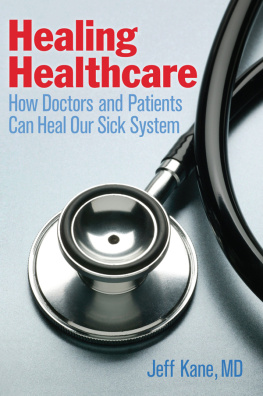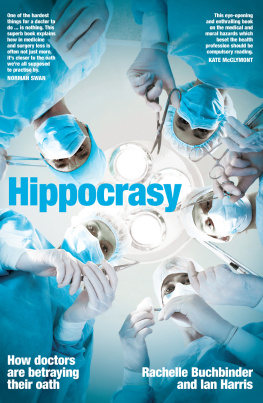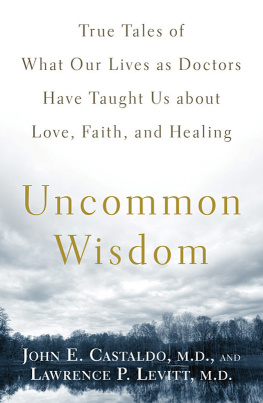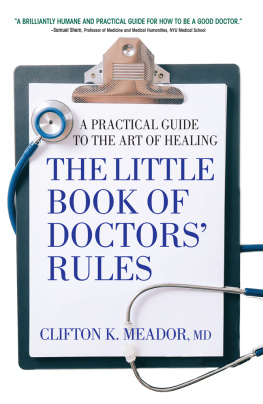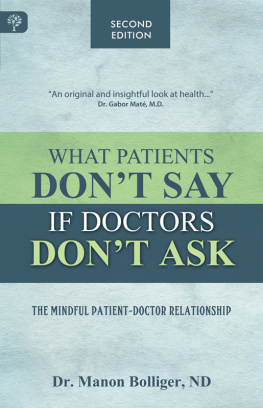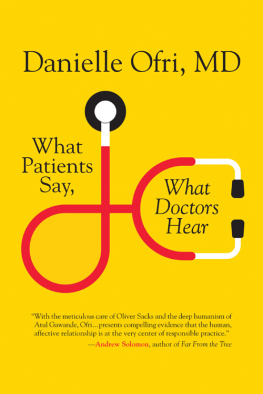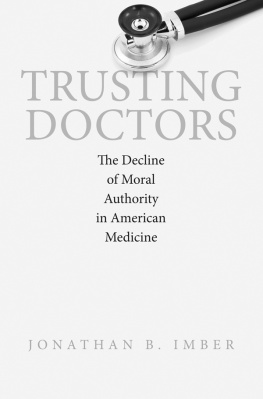THE FINEST TRADITIONS OF MY CALLING
ABRAHAM M. NUSSBAUM, M.D.
The Finest Traditions of My Calling
One Physicians Search for the Renewal of Medicine
Yale UNIVERSITY PRESS
NEW HAVEN AND LONDON
Published with assistance from the foundation established in memory of Amasa Stone Mather of the Class of 1907, Yale College.
Copyright 2016 by Abraham M. Nussbaum, M.D. All rights reserved. This book may not be reproduced, in whole or in part, including illustrations, in any form (beyond that copying permitted by Sections 107 and 108 of the U.S. Copyright Law and except by reviewers for the public press), without written permission from the publishers.
Yale University Press books may be purchased in quantity for educational, business, or promotional use. For information, please e-mail (U.K. office).
Set in Janson Oldstyle and Futura Bold types by Newgen North America.
Printed in the United States of America.
Library of Congress Control Number: 2015949625
ISBN 978-0-300-21140-5 (cloth : alk. paper)
A catalogue record for this book is available from the British Library.
This paper meets the requirements of ANSI/NISO Z39.481992 (Permanence of Paper).
10 9 8 7 6 5 4 3 2 1
AUTHORS NOTE
The book that you are reading contains true stories from my experiences as a physician. I changed the names and identifying details of some people to respect their privacy. The conversations in the book all come from my clear recollection of them and are not word-for-word transcripts. Instead, I retold them to evoke the feeling and meaning that was my experience.
To Elin
May I always act so as to preserve the finest traditions of my calling and may I long experience the joy of healing those who seek my help.
Hippocratic Oath
CONTENTS
PREFACE
You begin medical training by making promises. You swear oaths to your predecessors, to your patients, and to your creditors.
You are assigned to clinics and hospitals to learn from your betters. You listen to them, but when you see patients on your own you feel undone by all you cannot do. People fall ill in ways that startle you. Above all, ill people surprise you by placing their hopes on your unproven shoulders.
You persevere, you accrete experience, and around the time your first name is replaced by Doctor, you become accustomed to bearing these hopes. It takes a decade or so, but you find your own place in a clinic or hospital. You start teaching students of your own. You find yourself asking what you are doing in these clinics and hospitals, where people meet each other as patients and physicians.
Patients, practitioners, and policy makers ask the same question and conclude that we need to reform the healthcare system to which we now belong. Patients routinely survive illnesses that would have felled them only a few decades ago, but they are disappointed by clinics and hospitals. They complain that receiving healthcare is too alienating and too costly. Practitioners receive salaries and social status in excess of other members of caring professions, but report high levels of fatigue and frustration. They grouse that practicing medicine has become intolerable, and discourage students from becoming physicians. Policy makers appreciate the advances of medicine, but characterize the delivery of medical services as inefficient and ineffective. They are dispirited by the inequitable distribution of care. For all these reasons, we have decided it is time to reform healthcare.
When you hear about healthcare reform, it is often described like a boat race, with a discrete beginning and a certain end. Healthcare reform is something we can achieve or complete, something we can finish. When we reach the reform finish line, practitioners will provide care that will prevent many common illnesses. If people do fall ill, efficient practitioners will provide effective care at an affordable price.
When you practice medicine, healthcare reform seems less like a well-organized race and more like being at sea on an unmarked course of indeterminate distance. You cannot recall where the starting line is and cannot envision the finish line. You feel like a crewmember on a vast ship steered by multiple captains who cannot agree on the course. As you execute the shifting priorities of the captains, you become so concerned about keeping your place on the ship that you have little time to figure out where the ship is headed.
When you are lost, it helps to retrace your journey.
...
In The Finest Traditions of My Calling, I return to the oaths I swore at the beginning of my training, and to the best traditions of medicine to which they appeal. I discuss the ways medicine advanced by embracing science, statistics, industrial engineering, customer service, and social justice and the ways medicine is being transformed by healthcare reform. The book is not intended to be comprehensivea conspectus or summary of all the reform efforts going on in healthcarerather, it is a narrative search for a true reform, for the renewal of medicine. The search took me from a sprawling hospital to an ancient poorhouse, an army outpost, and a medical marijuana dispensary. It is a particular account by a specific physician, reflecting upon the oaths he swore, and wondering where this ship is headed.
At present, my own place on the ship is as the director of adult inpatient psychiatry at Denver Health, an academic safety-net hospital. At times, I have been a patient, a volunteer, a student, a trainee, an ethicist, a teacher, a quality-improvement officer, a researcher, an electronic medical record builder, and an administrator. Those experiences inform this book, which is about practicing medicine during healthcare reform and searching for a finish line, a fitting port. Even, perhaps, a port where healthcare is not simply reformed, but the practice of medicine is renewed.
ACKNOWLEDGMENTS
Some kids go premed in preschool. Once they start playing doctor, they never break character. In kindergarten, they dress as physicians for Halloween. In second grade, they plate bacteria for the science fair. In fourth grade, they understand worm dissection as a practice session for gross anatomy. Not me. I finished college before I ever thought of becoming a physician.
My own preschool games occurred in my grandfathers tire store. My sisters and I would clamber up a stack of belted radials, then leap into a pile of retreads, acting out the stories of our heroes and villains. Our games always returned to the one object in the shop that did not bear the logo of a tire manufacturer, a statue of a man rendered in rebar. He stood watch in the middle of the shop. His head was thrown back, his toothless mouth loosing a scream, his hands gripping his ribs as though he were prying open an escape hatch. From beneath his ribs, rusted cogs and wheels spilled out. We knew he was a sculpture, but we were afraid to touch him. His pain created a silence that separated him from us, a separation that I wondered how to resolve.
My journey from those wordless encounters with a body in pain to working as a physician was circuitous. I would never have arrived without assistance.
My four siblings, some of whom played with me in the tire shop, are my betters. Elisabeth is a better caregiver, Mary Margaret a better writer, Anna Cate a better thinker, and Andrew a better brother. I am grateful for their company and for their spouses and children who better our family.
Among my friends, I especially thank Andy Barton, who saved my life, and Tom Buller, who taught me what it means to go on after you lose a life.
My every step was guided by teachers, including Eva Aagaard, Neil Allman, Nadia Bolz-Weber, Andrew Ciferni, Karon Dawkins, Georgette Dent, Sue Estroff, Gary Gala, Stanley Hauerwas, Tess Jones, Nancy M. P. King, Michelle Kinney, Brett McCarty, David Moore, Jennifer Nelson, Laura and Roy Nichols, Lossie Ortiz, Don Spencer, Scott Stroup, and Joel Yager.
Next page

